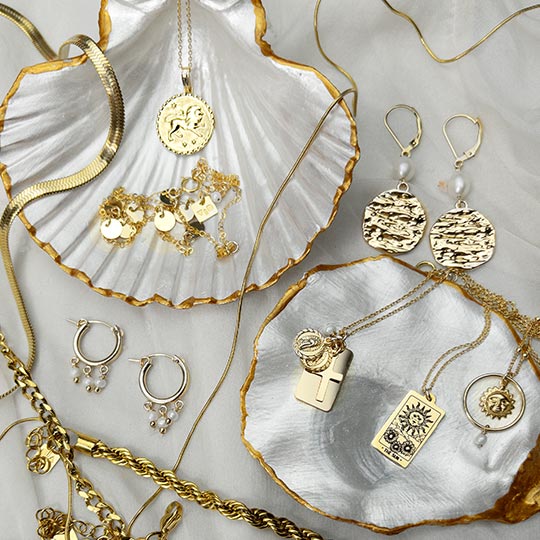Hey there!
Have you ever seen a piece of gold jewellery labelled “gold-filled” and wondered what the difference is?
Or have you seen two identical pieces but one is far more expensive than the other but you can’t tell the difference between either metal?
Well, fret no further! I’m here to clear everything up for you. By the end of this blog, you’ll be a connoisseur of all things gold.
Okay, so let’s start with the basic terms.
The 4 types of Gold most commonly used in jewellery are:

1. SOLID GOLD
Gold purity is defined and measured by its karatage (or more well known as carat), which is divided into 24 parts. This unit of measurement tells us the percentage of gold in a piece. Pure gold is 24 carats, which means 24 out of 24 parts are gold. However, pure gold is too soft and malleable to be used for jewellery, hence it is combined with various alloys like silver and copper to increase its strength and durability. Here’s a guide caratage and purity level of gold. 24k= 100% , 22k= 91.7%, 18k =75%, 14K =58.3%, 12K= 50%, 10k= 41.7%, 9k= 37.5% It’s important to note that there’s no “best” type of gold to use for every single design and application. Instead, each purity level has its own range of advantages that a jeweller must determine for each piece of jewellery.

2. GOLD FILLED
Gold-filled is certainly the closest alternative to solid gold. Jewellery made from gold-filled has a thick layer of solid gold mechanically heat and pressure bonded onto the base layer, usually high grade jewellers brass or sterling silver. It is durable, strong and lasting, and great for hyper sensitive skin. Here at sixD, all our pieces and also our gold-filled contains absolutely no aluminium, nickel, lead or tin, making it great for people who are allergic to metals, as our gold-filled will not cause an allergic reaction. Whilst solid gold contains the most gold, gold-filled jewelry typically contains 1/20th or 5% solid gold in total weight. Gold-filled jewellery is suitable for everyday wear, but without the price tag. It has the same qualities as solid gold jewellery at a fraction of the cost. Gold-filled jewelry is perfect for everyday wear and it's very affordable. With proper care, gold-filled jewellery can last a very long time

3. GOLD VERMEIL
In a nutshell, gold vermeil (French for silver, pronounced ver-may) is an old french technique that refers to the variety of gold gilded metal. For a piece of jewellery to be considered vermeil, it needs to meet three main trade criteria. The base of the metal must be of solid sterling silver (92.5%), the purity of the gold bonded must be of at least 10 karats, the thickness of the gold coat should consist of a minimum of 2.5 microns up to 3.5 microns. It does not tarnish and is hypoallergenic, so people with metal allergies can wear it safely. Some designs can’t be made gold-filled due to the way it’s formed and created, so we sometimes use gold vermeil in place. Gold vermeil is a great choice for those who want something to wear daily, that is lasting, hypoallergenic and still very affordable.

4.GOLD PLATED JEWELLERY
Gold plating is a method of depositing gold onto the surface of another metal, most often copper or silver (to make silver-gilt), via chemical or electrochemical plating. At sixD, our select gold plated pieces are achieved by bonding layers of gold on top of a base metal, usually high grade recycled brass. The layer of gold is electroplated onto the base alloy to create a gold plated piece of jewellery. We do not use flash plating (lower quality of gold, usually less than 0.25 microns thick). Instead, we use up to 3 microns of 14k gold or 18k gold, which is very high quality compared to the usual industry standards.

Why are there so many different colours of Gold?
You may have heard Gold described in a lot of different ways. People use the terms Yellow Gold, Rose Gold or White Gold when they describe the general color of the gold mixture. There is no real standard but a good general guide is;
Yellow Gold
Natural gold and colour-saturated alloys are what give yellow gold jewellery such a rich shine. The alloys most commonly used are copper with a red hue, and silver featuring a green hue. An exact mixture of copper or silver with the pure gold gives this precious metal its warmth.
White Gold
A silvery white character is what makes white gold jewellery so appealing. In order to make the gold white, it is combined with metal alloys that are white in nature and plated with an extremely hard element called rhodium.
Rose Gold
The beautiful pink hue of rose gold jewellery is created by using a copper alloy. Again, the overall percentages of metal alloys is the same for rose gold as it is for yellow or white, there is just a different mixture in what alloys are used.
So which process is the best?
The answer to this depends on where you’re getting your jewellery from and who is making it. Gold-vermeil and Gold plate isn’t inherently bad. It’s just difficult to get it right. If done cheaply, gold-plating can cause reactions in sensitive skin and tarnishes easily. To do Gold plate correctly and safely for sensitive skin requires a special technique and knowledge in which sixD employs for our select pieces. Absolutely all of our pieces exclude aluminium,nickel, lead or tin making it perfect for super sensitive skin.
What does sixD use?
Our current collections are made from solid gold, gold-filled, solid sterling silver, rhodium, gold vermeil and high quality gold plate. Our gold-filled is composed of a solid layer of gold (typically constituting at least 5% of the item's total weight) mechanically heat and pressure bonded to a base of either high grade jewellers brass or sterling silver. The outcome is a thick layer of solid gold that is durable and lasting. Although like anything, it is important to stay flexible in what methods and techniques we use as gold-filled isn’t suitable for every design and isn’t a one-size fits all. Just like different fabrics are used to create different items of clothing, jewellery is the same, the metals and techniques used must be right for each piece. We are open to and have previously used high quality gold vermeil and gold plate techniques when the design requires it. On our website we have all the metal info for your specific piece in the description section.
Why does sixD use gold-filled?
As someone who has struggled with extremely sensitive, acidic skin; I have been on a lifelong search for a truly hypoallergenic alternative to solid gold jewellery. Poorly made non-solid-gold jewellery has caused me to break out in rashes, preventing me from wearing anything for months on end. Our gold-filled method is a great alternative to solid gold. In our Sydney-based studio we have finessed our technique to cater for allergies and skin hypersensitivity. I come from a working class background and was exposed to the world of high end luxury jewellery and quality metals through apprenticing with an Australian Opal specialist in my early years of jewellery design. Working out the best techniques to make my designs come to life, that is both beautiful and lasting is what I do. I understand more than anyone the importance of durable jewellery that doesn’t hurt your skin or your bank. sixD’s pieces are made to last with appropriate care. Our goal is to create pieces you don’t think about when you’re wearing them and can be worn all the time without a breakout.
How do we source our metals?
We use recyclable solid sterling silver and source locally wherever possible. We create our gold-filled metal in-studio. I personally handle and quality control every piece that leaves our workshop. All of our jewellery is made with longevity and sustainability as our top priority.
Is gold-filled for me?
Yes! It is perfect for anyone who loves to never take their gold jewellery off. It is waterproof and only requires to be cleaned with warm soapy water and a soft cloth. It is also perfect for break-out prone skin and users who are hyper sensitive to the weight and feel of heavy jewellery. There is no aluminium, nickel, lead or tin used in all our pieces, ensuring it is 100% hypoallergenic. Investing in sustainable long-lasting pieces also helps to reduce your carbon footprint so you’re not forced to continue to buy the same cheap jewellery every couple of months. A fraction of the price of real gold, it is a true keepsake that with TLC will be with you for a long time.

